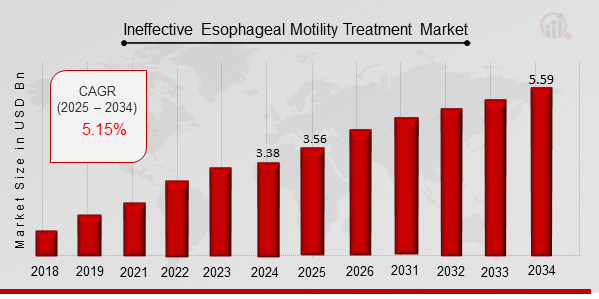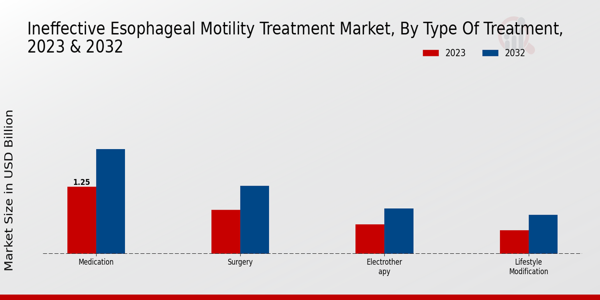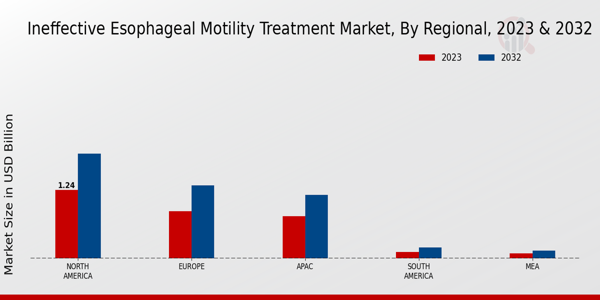Ineffective Esophageal Motility Treatment Market Overview
As per MRFR analysis, the Ineffective Esophageal Motility Treatment Market Size was estimated at 3.38 (USD Billion) in 2024. The Ineffective Esophageal Motility Treatment Market Industry is expected to grow from 3.56 (USD Billion) in 2025 to 5.59 (USD Billion) till 2034, at a CAGR (growth rate) is expected to be around 5.15% during the forecast period (2025 - 2034).
Key Ineffective Esophageal Motility Treatment Market Trends Highlighted
The Ineffective Esophageal Motility Treatment Market is driven by an increasing prevalence of esophageal disorders and a growing awareness of gastrointestinal health. As populations age and lifestyle factors contribute to digestive issues, the demand for effective treatment options continues to rise. Additionally, advancements in medical technology and therapies have led to innovative solutions aimed at improving esophageal motility. This has captured the attention of healthcare providers and patients alike, fostering a market environment focused on enhancing the quality of life for individuals suffering from these conditions.
There are significant opportunities to be explored within this market, particularly in developing targeted therapies and personalized medicine approaches.Research into the underlying causes of ineffective esophageal motility is paving the way for more effective and tailored treatments that could lead to improved patient outcomes. Furthermore, the integration of digital health technologies and telemedicine presents avenues for better patient monitoring and adherence to treatment protocols. These advancements could support healthcare professionals in managing and treating esophageal motility disorders more effectively, enhancing the overall treatment landscape.
Recent trends in the Ineffective Esophageal Motility Treatment Market include a shift towards minimally invasive procedures and increased collaboration between pharmaceutical companies and research institutions.This collaboration is facilitating the development of novel therapeutic agents and improving diagnostic techniques, ultimately leading to better management of esophageal conditions. Additionally, growing investment in healthcare infrastructure and awareness campaigns is expected to further stimulate the market as patients become more informed about their conditions and available treatment options. Overall, the interplay of these factors is shaping a dynamic landscape in the treatment of ineffective esophageal motility, creating opportunities for growth and innovation in this critical area of healthcare.

Source Primary Research, Secondary Research, MRFR Database and Analyst Review
Ineffective Esophageal Motility Treatment Market Driver
Increasing Prevalence of Esophageal Disorders
The Ineffective Esophageal Motility Treatment Market Industry is witnessing significant growth due to the rising prevalence of esophageal disorders such as achalasia, esophageal spasms, and other motility disorders. This increase is attributed to various factors including lifestyle changes, dietary habits, and a growing aging population more susceptible to gastrointestinal conditions. With advancements in diagnostic techniques, more patients are being identified and diagnosed with ineffective esophageal motility issues, leading to an uptick in demand for effective treatment solutions.Furthermore, as awareness about esophageal motility disorders grows among healthcare professionals and patients alike, there is a surge in the need for innovative therapies and management options.
The market is thus driven by the urgency to address the rising number of patients seeking treatment, fostering an environment ripe for expansion and innovation in therapeutic offerings. As the industry progresses, developing tailored treatment plans and enhancing patient engagement will become critical factors influencing market dynamics, compelling manufacturers to invest in research and development.The expected rise in market value reinforces the notion that investments in addressing these conditions will be pivotal for both patients and healthcare providers.
Advancements in Treatment Technologies
Technological advancements in the treatment of ineffective esophageal motility are a crucial driver of growth in the Ineffective Esophageal Motility Treatment Market Industry. Emerging therapies, including minimally invasive surgical techniques and novel pharmacological agents, offer enhanced treatment outcomes and improved patient comfort. These advancements not only provide solutions to previously challenging conditions but also enable healthcare providers to offer a wider range of therapeutic options that cater to individual patient needs.Additionally, the integration of telemedicine and digital health solutions in managing esophageal disorders facilitates better monitoring and follow-up care, further driving the market.
Growing Awareness About Esophageal Health
Public awareness campaigns aimed at educating individuals about esophageal health are significantly contributing to the growth of the Ineffective Esophageal Motility Treatment Market Industry. Increased knowledge about symptoms and risks associated with esophageal motility disorders encourages individuals to seek timely medical advice and treatment. As healthcare providers focus on preventive care and early intervention, the market is poised to expand, fueled by proactive patient engagement in managing their health.
Ineffective Esophageal Motility Treatment Market Segment Insight
Ineffective Esophageal Motility Treatment Market Type of Treatment Insights
The Ineffective Esophageal Motility Treatment Market revenue is driven by various types of treatment options. In 2023, the entire market was valued at 3.06 USD Billion, reflecting a strong focus on addressing ineffective esophageal motility through multiple approaches. Among the different types of treatments, medication holds a significant share, valued at 1.25 USD Billion in 2023, and is projected to increase to 1.95 USD Billion by 2032.
This growth in the medication sector is primarily due to the widespread prevalence of motility disorders and pharmaceutical advancements that lead to more effective treatment options.Following medication, surgery stands out as another vital treatment type with a value of 0.82 USD Billion in 2023, expected to grow to 1.27 USD Billion by 2032, as it addresses severe cases of esophageal motility disorders where other interventions may not suffice. Electrotherapy, valued at 0.55 USD Billion in 2023 and anticipated to reach 0.85 USD Billion in 2032, is also gaining traction as a non-invasive option that offers therapeutic benefits, making it an attractive alternative for patients.
Lastly, lifestyle modification, although considered a supportive treatment, accounted for 0.44 USD Billion in 2023, projected to rise to 0.73 USD Billion by 2032, highlighting its crucial role in managing symptoms and improving patient quality of life.Overall, the Ineffective Esophageal Motility Treatment Market segmentation illustrates the diverse strategies employed to effectively manage this condition, with the medication and surgery sectors dominating the landscape due to their profound impact on treatment outcomes and patient care. Growth drivers for this market include a rising incidence of esophageal motility disorders, increased awareness of available treatment options, and advancements in medical technology. However, challenges such as high treatment costs and limited patient access to specialized care facilities may hinder growth.
Despite these challenges, opportunities exist for market players to explore innovative treatment solutions and tailor approaches to meet patient needs, ensuring that they address the evolving landscape of ineffective esophageal motility treatment effectively. Observing the data, it’s evident that these treatment types collectively contribute to achieving better health outcomes and enhancing the overall quality of life for affected individuals. The Ineffective Esophageal Motility Treatment Market Statistics underline this shift in focus toward more holistic and effective management strategies for patients suffering from these disorders.
Source Primary Research, Secondary Research, MRFR Database and Analyst Review
Ineffective Esophageal Motility Treatment Market End User Insights
In 2023, the Ineffective Esophageal Motility Treatment Market was valued at 3.06 USD Billion, reflecting a steady growth trajectory influenced by multiple factors. The End User segment is crucial, comprising diverse settings such as hospitals, clinics, and homecare environments. Hospitals play a significant role in this market due to their comprehensive facilities and specialized staff that cater to patients with complex needs. Clinics contribute by offering accessible treatment options, bridging the gap for those who require outpatient services.Homecare settings are increasingly important, providing convenience and personalized care for patients managing chronic conditions.
The emphasis on patient-centered care and the rising prevalence of esophageal disorders are driving this market's growth. Furthermore, innovative treatment methodologies and improved patient awareness are supporting the demand across these segments. As the market evolves, access to effective treatment in diverse settings will remain a key focus, which enhances overall patient outcomes in the Ineffective Esophageal Motility Treatment Market.The Ineffective Esophageal Motility Treatment Market statistics underscore the significant potential existing within these end-user segments to address the growing healthcare needs.
Ineffective Esophageal Motility Treatment Market Route of Administration Insights
The Ineffective Esophageal Motility Treatment Market focuses on various Routes of Administration, which play a crucial role in the effectiveness of therapeutic interventions. As of 2023, the market is valued at 3.06 billion USD, reflecting a consistent demand for efficient treatment options. The market growth is fueled by the increasing prevalence of esophageal disorders and the need for timely interventions. Within the Routes of Administration, Oral administration dominates due to its ease of use and patient compliance, making it a preferred choice for many healthcare providers.Intravenous routes are also significant, especially for patients requiring rapid therapeutic action or those who cannot take medications orally.
Topical applications, while less prominent, offer targeted relief and are utilized in specific cases. The diversity of administration routes contributes to the overall Ineffective Esophageal Motility Treatment Market revenue, allowing flexibility in treatment plans tailored to patient needs. The market experiences growth driven by advancements in formulation technologies and increasing healthcare expenditure, although challenges such as regulatory hurdles and patient awareness remain pertinent.Understanding these aspects of the Ineffective Esophageal Motility Treatment Market segmentation helps in strategizing effective treatment approaches and improving patient outcomes.
Ineffective Esophageal Motility Treatment Market Diagnosis Method Insights
The Ineffective Esophageal Motility Treatment Market stands at a valuation of 3.06 USD Billion in 2023, highlighting a substantial demand for effective diagnosis methods. This market's segmentation includes key methods such as Manometry, Endoscopy, and Imaging Techniques, which play critical roles in diagnosing esophageal motility disorders. Manometry is especially vital as it measures the pressures and patterns of muscle contractions, providing essential data for treatment plans.
Endoscopy, on the other hand, allows direct visualization of the esophagus, aiding in identifying structural abnormalities and contributing significantly to the diagnostic process.Imaging Techniques are also important, offering non-invasive insights into esophageal function and facilitating comprehensive assessments. As the market evolves, the growth is supported by increasing prevalence rates of motility disorders and advancements in technology that enhance diagnostic accuracy. However, challenges such as the high costs of advanced diagnostic equipment may impede market growth. Overall, the combination of these methods highlights the diverse approaches in the Ineffective Esophageal Motility Treatment Market, presenting opportunities for innovation and improved patient outcomes.
Ineffective Esophageal Motility Treatment Market Regional Insights
The Ineffective Esophageal Motility Treatment Market is witnessing substantial growth across various regions, playing a critical role in enhancing healthcare outcomes. In 2023, North America leads with a valuation of 1.24 USD Billion, expected to rise to 1.89 USD Billion by 2032, indicating its dominance in the market. Europe follows with a market value of 0.85 USD Billion in 2023 and projected growth to 1.32 USD Billion by 2032, reflecting significant advancements in treatment options and accessibility. In the APAC region, the market reached 0.76 USD Billion in 2023 and is anticipated to expand to 1.15 USD Billion by 2032, owing to increasing healthcare investments and awareness of motility disorders.South America and MEA, although smaller in scale, show growth potential, with valuations of 0.12 USD Billion and 0.09 USD Billion in 2023, respectively, progressing to 0.20 USD Billion and 0.14 USD Billion by 2032.
The regional segmentation illustrates a diverse landscape where North America dominates primarily due to advanced healthcare infrastructure and a higher prevalence of esophageal disorders while emerging markets like APAC present new opportunities for growth. The Ineffective Esophageal Motility Treatment Market statistics reveal a vibrant shift towards innovative treatment solutions driven by increasing patient awareness and the urgent need for effective therapies globally.
Source Primary Research, Secondary Research, MRFR Database and Analyst Review
Ineffective Esophageal Motility Treatment Market Key Players and Competitive Insights
The Ineffective Esophageal Motility Treatment Market is characterized by its dynamic landscape influenced by the increasing prevalence of esophageal disorders that affect patient quality of life. In this market, numerous players are engaging in innovative treatment development aimed at improving therapeutic outcomes for individuals with conditions related to esophageal motility. The competitive environment is shaped by various factors, including the effectiveness of treatment options, advancements in technology, regulatory approvals, and partnership strategies among companies.
Additionally, the presence of a diverse array of products, ranging from surgical interventions to less invasive therapeutic modalities, contributes to a competitive marketplace where companies continually strive to differentiate themselves through enhanced clinical efficacy, safety profiles, and patient satisfaction.EndoGastric Solutions has emerged as a key player in the Ineffective Esophageal Motility Treatment Market, harnessing its strengths to address the unique challenges faced by patients with esophageal motility disorders. The company is known for its innovative approaches in offering minimally invasive solutions, which are designed to treat ineffective motility while ensuring reduced recovery times and improved patient comfort. EndoGastric Solutions places a strong emphasis on research and development, allowing them to remain at the forefront of technological advancements and clinical practices.
Their focus on delivering high-quality outcomes for patients positions them favorably within the competitive landscape as they work to establish a solid market presence through effective collaborations and strategic partnerships.Bard Peripheral Vascular operates with a distinct approach within the Ineffective Esophageal Motility Treatment Market, contributing to advanced treatment modalities that cater to this specific patient demographic. The company is known for developing and manufacturing medical devices that enhance the efficacy of treatments aimed at managing esophageal motility disorders. With a robust presence in the healthcare sector, Bard Peripheral Vascular leverages its extensive experience in vascular technologies to address issues related to esophageal function effectively.
Their commitment to innovative solutions, alongside a focus on rigorous clinical testing, solidifies their reputation within the market, enabling them to offer products that meet the evolving needs of patients and healthcare providers alike. Bard Peripheral Vascular is well-positioned to capitalize on market opportunities due to its established infrastructure and dedication to advancing therapeutic options.
Key Companies in the Ineffective Esophageal Motility Treatment Market Includ
Ineffective Esophageal Motility Treatment Market Industry Developments
Recent developments in the Ineffective Esophageal Motility Treatment Market have seen various companies enhancing their product offerings and exploring new technologies to address patient needs. EndoGastric Solutions has gained attention for its innovative procedures aimed at improving esophageal function, while Medtronic and Boston Scientific are expanding their portfolios through advanced device technologies. Inspire Medical Systems continues to push boundaries with its neuromodulation therapy, gaining traction among patients with motility disorders.
Notably, the market has witnessed increased interest from Abbott Laboratories and Cook Medical as they invest in R&D to innovate treatment solutions. Merger and acquisition activity remains vibrant, with several key players in discussions to enhance market share and technological capabilities. For instance, the potential collaboration between Medtronic and significant players in the industry may catalyze advancements in esophageal treatment methodologies. As the market evolves, the growth in valuation for companies such as Teleflex and Stryker indicates robust demand for effective treatments, providing opportunities for investment and strategic growth within this specialized area of healthcare. The sector is poised for significant evolution as these companies respond to ongoing advancements and the increasing prevalence of esophageal motility disorders.
Ineffective Esophageal Motility Treatment Market Segmentation Insights
-
Ineffective Esophageal Motility Treatment Market Type of Treatment Outlook
-
Ineffective Esophageal Motility Treatment Market End User Outlook
-
Ineffective Esophageal Motility Treatment Market Route of Administration Outlook
-
Ineffective Esophageal Motility Treatment Market Diagnosis Method Outlook
-
Ineffective Esophageal Motility Treatment Market Regional Outlook
| Report Attribute/Metric |
Details |
|
Market Size 2024
|
3.38 (USD Billion)
|
|
Market Size 2025
|
3.56 (USD Billion)
|
|
Market Size 2034
|
5.59 (USD Billion)
|
|
Compound Annual Growth Rate (CAGR)
|
5.15 % (2025 - 2034)
|
|
Report Coverage
|
Revenue Forecast, Competitive Landscape, Growth Factors, and Trends
|
|
Base Year
|
2024
|
|
Market Forecast Period
|
2025 - 2034
|
|
Historical Data
|
2020 - 2024
|
| Market Forecast Units |
USD Billion |
| Key Companies Profiled |
EndoGastric Solutions, Bard Peripheral Vascular, Stimwave, Johnson and Johnson, Inspire Medical Systems, NuVasive, Medtronic, Boston Scientific, Cook Medical, Abbott Laboratories, Merit Medical Systems, ConMed, Teleflex, Stryker, Halyard Health |
| Segments Covered |
Type of Treatment, End User, Route of Administration, Diagnosis Method, Regional |
| Key Market Opportunities |
Rising prevalence of esophageal disorders, Advancements in minimally invasive therapies, Increased investment in R, Growing demand for personalized medicine, Expansion of telemedicine for patient outreach |
| Key Market Dynamics |
Increasing prevalence of esophageal disorders, Growing demand for minimally invasive therapies, Advancements in diagnostic techniques, Rising geriatric population, Expanding technological innovations in treatments |
| Countries Covered |
North America, Europe, APAC, South America, MEA |
Frequently Asked Questions (FAQ) :
The Ineffective Esophageal Motility Treatment Market is expected to reach a value of 5.59 USD Billion by 2034.
The market is anticipated to grow at a CAGR of 5.15% from 2025 to 2034.
North America is expected to dominate the market with a valuation of 1.89 USD Billion in 2032.
The medication segment is projected to reach 1.95 USD Billion in 2032.
Key players include EndoGastric Solutions, Medtronic, Boston Scientific, and Johnson Johnson.
The surgery segment was valued at 0.82 USD Billion in 2023.
The electrotherapy treatment segment is anticipated to grow to 0.85 USD Billion by 2032.
The APAC region is expected to see considerable growth, reaching 1.15 USD Billion by 2032.
The lifestyle modification segment is forecasted to reach 0.73 USD Billion in 2032.
South America is expected to contribute 0.2 USD Billion to the market by 2032.

















